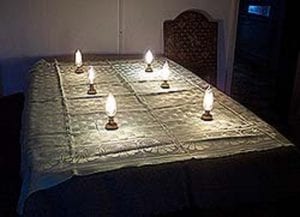 Crime
Crime  Crime
Crime  Technology
Technology 10 Hilariously Over-Engineered Solutions to Simple Problems
 Miscellaneous
Miscellaneous 10 Ironic News Stories Straight out of an Alanis Morissette Song
 Politics
Politics 10 Lesser-Known Far-Right Groups of the 21st Century
 History
History Ten Revealing Facts about Daily Domestic Life in the Old West
 Weird Stuff
Weird Stuff 10 Everyday Products Surprisingly Made by Inmates
 Movies and TV
Movies and TV 10 Actors Dragged out of Retirement for One Key Role
 Creepy
Creepy 10 Lesser-Known Shapeshifter Legends from Around the World
 Animals
Animals 10 Amazing Animal Tales from the Ancient World
 Gaming
Gaming 10 Game Characters Everyone Hated Playing
 Crime
Crime 10 Terrifying Serial Killers from Centuries Ago
 Technology
Technology 10 Hilariously Over-Engineered Solutions to Simple Problems
 Miscellaneous
Miscellaneous 10 Ironic News Stories Straight out of an Alanis Morissette Song
Who's Behind Listverse?

Jamie Frater
Head Editor
Jamie founded Listverse due to an insatiable desire to share fascinating, obscure, and bizarre facts. He has been a guest speaker on numerous national radio and television stations and is a five time published author.
More About Us Politics
Politics 10 Lesser-Known Far-Right Groups of the 21st Century
 History
History Ten Revealing Facts about Daily Domestic Life in the Old West
 Weird Stuff
Weird Stuff 10 Everyday Products Surprisingly Made by Inmates
 Movies and TV
Movies and TV 10 Actors Dragged out of Retirement for One Key Role
 Creepy
Creepy 10 Lesser-Known Shapeshifter Legends from Around the World
 Animals
Animals 10 Amazing Animal Tales from the Ancient World
 Gaming
Gaming 10 Game Characters Everyone Hated Playing
10 Things in the Edwardian Home That Could Kill You
After Queen Victoria died in 1901, her son Edward VII was crowned king, and the Edwardian Era began. Being deep into the Industrial Revolution, with a fresh new king, invention and innovation ran wild in early 20th-century Britain. All of a sudden, there were department stores containing asbestos—which was in everything—electric wiring in homes with indoor lighting, indoor plumbing, refrigerators, vacuums, telephones, cars, and radium.
Yes, it was an era of wonders, but it could also be a dangerous and lethal era. So read on to discover how people managed to kill themselves so frequently and efficiently during the golden days of the Edwardian period.
Related: 10 Ingenious Cutlery Inventions From The Victorian Era
10 Edwardian Women Wore Killer Hats
No respectable Edwardian woman would even dream of leaving the house without her most flamboyant hat firmly attached to her equally flamboyant hairdo. Some of these things were 24 inches (61 centimeters) wide and took quite a bit of effort, along with some rather vicious pieces of hardware to securely attach them. These were in the form of hat pins, which could be two-thirds as long as a woman’s hat was wide—up to 16 inches (40 centimeters)!
These things were so potentially harmful that cities like Chicago and Paris banned exposed hat pins because too many bystanders were getting injured by them. Unbelievably, instead of just painfully poking someone, they could just as easily take out an eye. What was worse, these ginormous hats were so difficult to put on and take off that the women would leave them on wherever they went, indoors or out, so they were a constant threat wherever they were.
And it gets worse. Bird feathers on the hat were all the rage among Edwardian women, with many going so far as to have whole, dead birds sewn onto their already elaborate hats. Many concerned citizens got fed up with the senseless exploitation of the creatures, and in 1908, the Society for the Protection of Birds lobbied for laws banning the horrible practice. As a result, in 1921, the Importation of Plumage Prohibition Bill was passed and became law.[1]
9 Gas + Electric = BOOM, You’re a Dead Edwardian!
At the start of the Edwardian period, when electricity first became available to the general public, many Victorian-era homes had already been plumbed for gas lighting and other appliances, creating an explosive mixture of the two new technologies, neither of which were well understood by the inventors, or those using them. Edwardian electric service was installed using bare copper wire because they hadn’t yet grasped the concept of insulation. Still, they or their customers would soon enough as the poor souls grasped the wrong bare wires and died on the spot.
Yet that wasn’t the only potential lethal hazard these two energy sources created together. There was also the possibility of gas leaks from a number of early gas appliances, such as gas-fired cooking stoves, lighting fixtures, and heated bathtubs, for example. These caused a catastrophic explosion when someone simply plugged something in or turned a light on.
Early electricians didn’t even know that a building needed to be grounded to the earth for safety from electrocution, and their Edwardian patrons also used multiple electrical adapters and loaded them up with multiple devices, setting curtains or furniture ablaze after they overheated and caught fire. And to make matters even worse, to increase profits, the gas companies would turn the gas pressure down after dark, many times causing gaslights to go out, letting a slow trickle of it escape and potentially blow the building up. [2]
8 The Edwardians Had Killer Asbestos Products
At the beginning of the Edwardian era, worldwide asbestos mining had grown to over 30,000 tons (27,216 tonnes) per year. And the industry was just getting started, causing children and women to enter the asbestos workforce, preparing and packaging the mineral for use by the public while their menfolk worked the mines.
Asbestos is now known to be a deadly killer and comes in four distinct flavors. First, there’s “pleural” mesothelioma, with symptoms such as pain in the side of the chest or lower back, shortness of breath, cough, trouble swallowing, hoarseness, and swelling of the arms and face, and “peritoneal,” mesothelioma, “pericardial” mesothelioma, and finally, “general” mesothelioma, all with more or less identical symptoms, making them hard to differentiate, from themselves, or other diseases.
We can’t forget to mention asbestosis either, which is similar to mesothelioma, just not quite as bad. Miners and manufacturing employees would bring asbestos fibers home to their spouses, who would develop asbestosis from washing their work clothes. It seems as though asbestos was a lot like mustard or paint—it could end up everywhere.[3]
7 Edwardians Were Literally “Plumb Crazy” over Indoor Plumbing
Since the invention of plumbing, lead has been involved, and although that may sound exaggerated, consider this: the inventors of modern plumbing, the ancient Romans, couldn’t have done it without lead since they wanted their lead pipes made yesterday. The ancient Egyptians had plumbing, but they used clay pipes at first, then copper. Some think the Romans used lead for water pipes because it was so easy to work with compared to clay or copper. Lead is soft, has a very low melting point, and is easily cast, making it an excellent choice—except that the insidious metal is deadly poisonous.
Some scholars say that the Roman Empire fell due to chronic lead poisoning, which was especially true for the elite, who used it for everything and even consumed it. Ironically, humans didn’t get the memo about lead, at least in America, until 1978, when it was finally banned for use as an interior paint and fuel additive. This means that lead plumbing was highly prevalent during the Victorian era, making it widespread from the start of the Edwardian age and adding to the problem.
The saying “plumb crazy” isn’t always a joke. Lead’s symbol on the periodic table is Pb, from the Latin word plumbum, and being “plumb crazy” back then was real and came with real symptoms. The following is from the National Library of Medicine on lead toxicity: “Lead poisoning is the most common disease of environmental origin in the United States today. Lead-induced toxicity to the central nervous system causes delayed development, diminished intelligence, and altered behavior.” Hmm? “delayed development, diminished intelligence, and altered behavior.” Sure sounds like plumb crazy is possible to me.[4]
6 The Edwardian “Fridge” Was a Cold-Blooded Killer
The Edwardian kitchen saw the most promising innovations to take the drudgery out of the housewife’s day and give them more time for other tasks or leisurely activities. These inventions, though, came with a heavy price and in more ways than one. The star of every Edwardian kitchen was the refrigerator, which was very expensive at £700. It cost more than a new car, which was around £500 at the time. Just to give you an idea, one 1908 British pound is worth over 151 today, so the Edwardians were spending a small fortune to keep food cold.
The preservation of food was a necessary priority during Edwardian times. They initially built wood cold cabinets, crafted as a piece of fine furniture lined with sawdust, and then packed with ice shipped all the way from the Artic, which was packed around the food items. The obvious problem with this setup was that the ice never lasted very long and had to be constantly replenished, so they needed a better solution, which came in the form of technology.
Professor Charles Graham of South Bank University has an example of an early refrigerator built around 1870. The model was never mass-produced but perfectly illustrates the first attempts at mechanical and chemical refrigeration and how shaky these units were. Professor Graham explains how the first production models to go on the market had very similar problems that the huge experimental unit from 1870 had, which was profuse leaking of the refrigerants used, which were all toxic—and some were even explosive.
One of the first refrigerants used was ammonia which was not only toxic but also flammable. Couple that with the leaking of flammable, toxic gas, and you have homeowners choking on ammonia while running out of the house in a panic, only to have the gas build up to the correct air-to-gas ratio and BOOM! A gas light left burning triggers a massive explosion, and the house blows up. That’s a steep price to pay to keep a pint of milk cold. In addition to ammonia, used for making gunpowder, they used other gases that were weaponized during World War I as well. What were they thinking, right?[5]
5 Edwardian Women’s Cosmetics Made Them Drop-Dead Gorgeous
The Industrial Revolution of the Victorian Age gave Edwardian women access to mass-produced cosmetics at constantly lowering costs, so it’s not much of a surprise that the beauty counter was invented during the period. To the women of the Edwardian period, a pale white complexion was desired by just about all women, and this was where the beauty counter came into play. It was one of the places they went to achieve that special look they desired. They could be seen merrily painting their faces with white, lead-based face paint or using arsenic in the form of wafers they’d eat to assist with this, along with an array of soaps and powders containing the deadly elemental metal.
Another attribute of beauty that was all the rage was dilated pupils for that strung-out “junkie look” they wanted so badly. For that they’d use poisonous belladonna drops, and the eye shadow they would apply contained both mercury and lead, often leading to blindness. It almost seems as if the era wasn’t dangerous enough for the Edwardian people that they had to compound everything about their daily lives with toxins without even being aware of it, either to save time in an ever-increasingly rushed world or simply just to be “in vogue.”[6]
4 Edwardian-Era Radium Products Were All the Radioactive Rage
In 1898, the isolation of radium by scientists Marie and Pierre Curie immediately grabbed the imagination of the public. Due to being so rare at first, radium was described as “the most expensive substance in the world,” while the press picked it apart like a Christmas turkey. Despite what they were writing about it, science viewed radium as a super cure for ailments like tuberculosis and cancer. It was also praised by a new mass market called the beauty industry, which claimed radium to be a cure-all for female issues such as unwanted hair, crow’s feet, and wrinkles.
Two cases would emerge that brought the beautifying properties of radium to a screeching halt. The first occurred in the states at New Jersey’s U.S. Radium Corporation, which first opened in 1917. It had done work for the military during World War I, making luminous dial faces with radium-based paint for instrumentation in vehicles and aircraft. Women were employed to paint these dials and would use their lips to twist the bristles into a point, ingesting radium paint while doing so.
After several years of painting close to 1,400 dials in a fifty-five-hour work week, the girls started getting sick. Some would develop “radium jaw”—a condition that causes the victim’s mandible to literally rot from their face. They would be dubbed the “Radium Girls” or “Legion of the Doomed,” and rightly so since nine of them would be dead within just seven years. The second case to hit the headlines was the demise of Eben M. Byers, who, after being injured, went to his doctor, who recommended something called “Radithor.”
This was the practice of consuming a premixed amount of radium-laced water that promised to cure many different ailments. Just five years later, Byers estimated that he’d drunk over a thousand bottles of the concoction and was presenting signs of radiation poisoning. Unfortunately, Byers had only a few months to live and had lost so much weight in the interim that he only weighed 92 pounds (41.7 kilograms) when he passed away in 1931. All the while, his skin was yellowing, and his bones were splintering into large slivers. Byer’s autopsy showed he had necrosis in both jaws, brain abscesses, anemia, ravaged bone marrow, and damaged kidneys. After Byer’s case was exposed by the media, the public’s enthusiasm for radium finally withered and died.[7]
3 Curling Irons And Edwardian Women’s Baldness
During the Edwardian age, the “Marcel way” of styling hair was all the rage for those girls who didn’t have wavy hair and was basically the world’s first hair straightener. There was also an array of curling irons on the market for those women who had straight hair and had to have those curls. These women would heat the curling devices up in a fire, on the stovetop, or with an alcohol burner designed specifically for that purpose. She would then wrap her hair around the hot device and steam the strands in place to give her those lovely curls she so desperately wanted—but at a higher price than she may wish to pay.
The Marcel wave was probably the main inspiration for the invention of German hairdresser Karl Nessler’s “electric permanent wave machine,” which he patented in London in 1909. Yet with “perms” taking so long and being so expensive, most women couldn’t afford it. A “permanent” option involved the hair being wrapped around rods, the precursors to curlers, and then coating it with substances such as asbestos and highly alkaline pastes.
Obviously, this process of high heating, with a toxic bath in chemicals, was bad for hair. Some researchers blame rampant female hair loss by Edwardian women of the period on these types of hair treatments since it is known today that using these methods can cause the hair to become brittle, die, and eventually fall out. I wonder if it was worth it. Probably not.[8]
2 Edwardian’s Used Electric Tablecloths

Dating back to 1902, the Parkin’s wondrous illuminating tablecloth utilized electric wires running along its length inside the lining, with the lamps being plugged directly into the fabric where the prongs would make the electrical contact they needed to work. The Parkin’s illuminating tablecloth was just one of many crazy electrical contraptions the Edwardian engineers were pumping out then. Electricity was a new and exciting phenomenon that grabbed the imaginations of people all over the world, but none more than the Edwardians, who reveled in it… many times to their deaths.
When the electric service they needed to run their electric tablecloth was installed, the electricians used completely bare copper wiring to do it. Without insulation or grounding, the accidental grasping or touching of these bare electric wires killed many people, including a lot of young children.
The Edwardians, due to complete ignorance of the dangers involved, would also use adapters with multiple outlets that would plug into a light bulb socket. They would then run just about every electrical device they owned through these adapters, which would overload the circuit, heat up the wiring, and then burst into flames, burning the entire house down. Unfortunately, these events were far too common in Edwardian times, and the newspapers of the day wrote horror stories about them almost daily. Needless to say, the Edwardians were willing to pay for their amenities with their lives.[9]
1 The Deadly Edwardian Electric Home
At the turn of the century, there were substantial improvements in the supply of utility services to residential homes. One of the biggest advancements was the adoption of bathrooms with hot and cold running water and fixed gas and electrical appliances that used these exciting new energy sources. Once water mains were installed around England, the difficulty of filling up a bathtub was no longer difficult. Your tub could even heat up the water for you—but you’d better be careful and not fall asleep in your gas-fired bathtub—or you might boil yourself to death like a lobster, as many Edwardians did. The gas-fired bathtub would suffice for personal hygiene, but what about the rest of the Edwardian house?
Well, there were several different methods by which Edwardians could kill themselves in their own homes. With electric service available to long-time gas customers, a very lethal combination was created. For example, with gas-fired lighting fixtures, and an unsafe electrical wiring system, the frequent gas leaks Edwardians dealt with all the time now became an explosive problem when someone plugged something in or turned something on while oblivious to the tasteless and odorous gas cloud surrounding them and filling up the house. Then BOOM! The roof goes away. This and other incidents, just as deadly, were an all too common occurrence during the exciting but dangerous Edwardian Era.[10]








